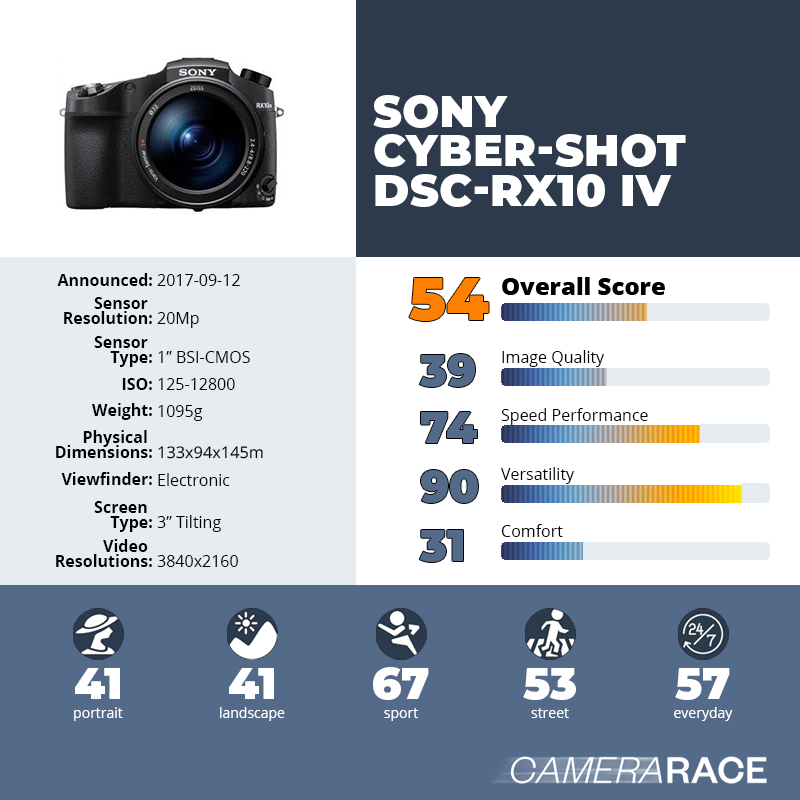give me a comparison between nikon 950 and this sony
Here is a detailed comparison between the Sony RX10 IV and the Nikon Coolpix P950 based on their specifications, features, and intended usage.
Sony RX10 IV
The Sony RX10 IV is a premium compact camera that features:
- Sensor: 20.1 Megapixel 1-inch Exmor RS CMOS sensor, providing high-quality images even in low light conditions.
- Lens: A built-in Zeiss Vario-Sonnar T* 24-600mm f/2.4-4 lens, offering a versatile zoom range suitable for a variety of shooting situations, from wide-angle landscapes to distant wildlife.
- Autofocus: Advanced Fast Hybrid AF system with 315 phase-detection points and 25 contrast detection points allows for rapid focus, making it ideal for action photography.
- Continuous Shooting: Capable of 24 frames per second (fps) continuous shooting, making it effective for capturing fast-moving subjects.
- Video Capabilities: 4K video recording with full pixel readout and no pixel binning, providing excellent quality for video enthusiasts.
- Build & Design: The camera is weather-sealed for outdoor usage and has an electronic viewfinder for clear shooting in various lighting conditions.
- Price Range: Approximately $1,609.95 CAD to $2,434.97 CAD.
Additional Features: The RX10 IV has excellent battery life, numerous customizable settings, and a tilting LCD screen that adds versatility to shooting angles.
Nikon Coolpix P950
The Nikon Coolpix P950 is a superzoom camera characterized by:
- Sensor: 16 Megapixel 1/2.3-inch CMOS sensor. While effective, it’s smaller than the sensor in the RX10 IV, which may impact performance in low light.
- Lens: An ultra-high-power optical zoom lens that ranges from 24mm to an impressive 2000mm equivalent, with Dynamic Fine Zoom up to 4000mm, making it suitable for distant subjects like wildlife and birds.
- Autofocus: Contrast Detect autofocus with 49 focus points; though effective, it may not be as fast as Sony's system in dynamic situations.
- Continuous Shooting: Can shoot at 7.5 fps, which is decent but slower than the RX10 IV.
- Video Capabilities: Records in 4K but has a more limited video feature set compared to the RX10 IV.
- Build & Design: It has a more traditional DSLR-like design and is also equipped with an electronic viewfinder.
- Price Range: Generally lower in price compared to the RX10 IV, with listings around $1,200 CAD.
Additional Features: The P950 has specialized modes for photographing birds and the moon, making it particularly appealing for nature photographers.
Conclusion
In summary, the Sony RX10 IV is tailored for those seeking high performance, particularly in autofocus speed, image quality, and video capability, making it more suitable for professional or serious hobbyist photographers. On the other hand, the Nikon Coolpix P950 excels in superzoom capabilities and affordability but may fall short in image quality and performance features compared to the RX10 IV.
Choosing between the two ultimately depends on your specific photographic needs—whether you prioritize lens versatility and zoom range or overall image quality and advanced features.Here’s a comparison between the Nikon Coolpix P950 and the Sony RX10 IV, focusing on their specifications, features, and overall capabilities.
Design and Build
- Nikon Coolpix P950:
- This camera features a robust and compact design typical of superzoom digital cameras.
- It has a sling-style grip, making it comfortable to hold during extensive shooting sessions.
- The build emphasizes portability, which is fitting for photographers who require a lightweight but powerful solution.
- Sony RX10 IV:
- The RX10 IV is also designed for portability with its compact form factor but is known for its premium build quality.
- The camera has an ergonomic grip and a more refined look typical of Sony's higher-end models.
Sensor and Image Quality
- Nikon P950:
- The Coolpix P950 boasts a 16.0 MP sensor, suitable for basic photography needs.
- It performs adequately in various lighting conditions but does not match the advanced capabilities of larger sensors.
- Sony RX10 IV:
- The RX10 IV features a 20.1 MP 1-inch Exmor RS BSI CMOS sensor, providing superior low-light performance and image quality.
- This larger sensor size helps achieve more dynamic range and better noise control at higher ISO levels.
Zoom and Lens Capabilities
- Nikon P950:
- The P950 is noted for its impressive 83x optical zoom (24-2000mm equivalent), making it excellent for capturing distant subjects.
- It includes Dual Detect Optical VR for minimization of camera shake, crucial for long-range shooting.
- Sony RX10 IV:
- The RX10 IV has a 25x optical zoom (24-600mm equivalent), which is still impressive but shorter than the P950’s range.
- However, it features a high-quality Zeiss Vario-Sonnar lens, known for image clarity and sharpness, along with Optical SteadyShot for stabilization.
Autofocus and Shooting Speed
- Nikon P950:
- The P950 includes contrast-detect autofocus, which is generally slower compared to phase-detection systems and can struggle in fast-moving scenes.
- It supports continuous shooting but is limited compared to newer models.
- Sony RX10 IV:
- The RX10 IV excels with its Fast Hybrid AF system, offering 315 phase-detection points that provide rapid and accurate focusing.
- It can shoot continuously at 24 fps, which is superb for wildlife and sports photography.
Video Capabilities
- Nikon P950:
- The P950 can record videos in 4K, which is suitable for amateur videographers wanting to capture high-resolution content.
- Sony RX10 IV:
- The RX10 IV also supports 4K video recording with full pixel readout, ensuring high-quality video with less moiré and aliasing.
- Additionally, it has advanced video features that appeal to professionals, such as S-Log profiles for better grading options.
Price
- The Nikon P950 typically comes in at a lower price point than the Sony RX10 IV, making it more accessible for casual users or those on a budget.
- Conversely, the RX10 IV's price reflects its comprehensive features, superior build quality, and performance.
Conclusion
In summary, if you require significant zoom capabilities and are budget-conscious, the Nikon Coolpix P950 could be a better choice for you. However, if you prioritize image quality, autofocus performance, video capabilities, and a more professional setup, the Sony RX10 IV stands out as an exceptional option amid the bridge cameras. The choice ultimately depends on your specific photography needs and how you prioritize aspects like zoom range versus overall image quality and performance.
For more details, you can explore the specifications of both cameras on their respective pages:
Sources


Related Questions
Work fast from anywhere
Stay up to date and move work forward with BrutusAI on macOS/iOS/web & android. Download the app today.
